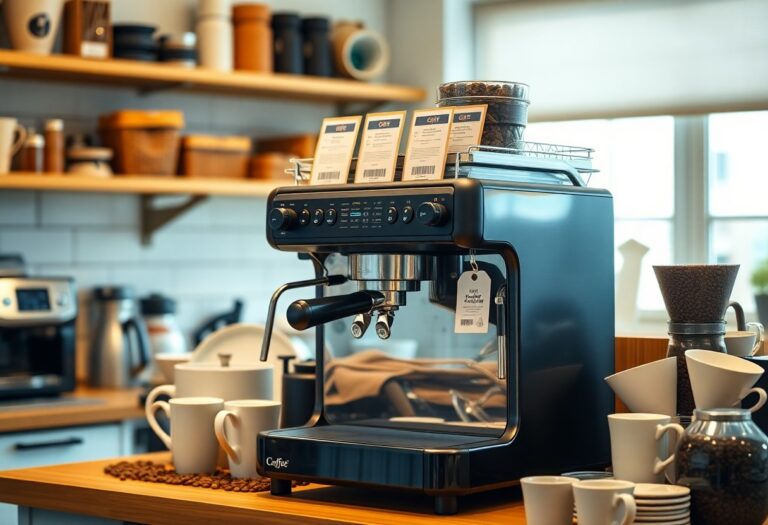What Coffee to Use in an Espresso Machine: Bean Selection Guide
Choosing the right coffee beans is essential to crafting an exceptional espresso. The flavor, aroma, and crema quality all depend on the beans you select. Using the correct beans tailored for your espresso machine unlocks the rich, intense experience espresso lovers seek.
This article, What Coffee to Use in an Espresso Machine: Bean Selection Guide, offers a comprehensive look at how to pick the best coffee beans for your espresso machine. You will learn about:
- Different types of coffee beans and how they influence taste
- The impact of roast levels on flavor and crema
- Why freshness matters more than you might think
- Comparing single-origin beans with blends for espresso
- Understanding flavor profiles suited to your preferences
- Ethical sourcing considerations
- Grinding techniques that enhance extraction
With this guide, you can confidently choose coffee beans that elevate every shot from your espresso machine.
Understanding Espresso Beans
When selecting beans for your espresso machine, understanding the differences between Arabica and Robusta is essential. These two species dominate the coffee world and bring distinct characteristics to your espresso shot.
Arabica Beans
Known for their smooth and refined flavor, Arabica beans offer sweeter, more complex profiles with floral, fruity, and sometimes nutty notes. They typically contain less caffeine—about half compared to Robusta—making them a favorite for those who prefer balanced espresso with subtle acidity and sweetness. Arabica’s delicate flavor shines when roasted medium to dark but retains complexity even at lighter roasts.
Robusta Beans
Robustas deliver a stronger, earthier taste with bitter and woody undertones. They contain significantly more caffeine, providing an extra kick in your espresso. Robusta also contributes to a thicker and richer crema because of its higher oil content. This makes it valuable in espresso blends where body and crema are priorities.
Espresso Blends: Enhancing Complexity and Crema
Espresso blends combine Arabica and Robusta beans or multiple Arabica origins to balance flavor complexity, aroma, and crema. Benefits include:
- Flavor Balance: Blends can highlight sweetness from Arabica while adding depth and strength from Robusta. This synergy creates richer layers of chocolatey, caramelized, or nutty notes.
- Consistency: Blending helps maintain flavor uniformity across batches despite variations in single-origin harvests.
- Improved Crema: The natural oils and caffeine in Robusta enhance crema thickness and stability, an important feature for authentic espresso experiences.
Blends give you versatility—whether you want a smooth, mild shot or a bold, intense one with lasting crema. Choosing the right blend depends on your taste preference and the style of espresso you enjoy brewing at home or professionally.
Roast Levels for Espresso
Roast level plays a significant role in shaping the taste and crema quality of your espresso shots. The degree to which coffee beans are roasted affects their chemical composition, which in turn impacts flavor intensity, acidity, body, and crema production.
Impact on Taste and Crema
- Darker roasts tend to yield a bolder, more robust flavor with lower acidity. The oils drawn out during roasting contribute to a thicker crema—the golden layer of foam atop an espresso shot.
- Medium roasts preserve more of the coffee’s original characteristics, including nuanced acidity and sweetness. They often produce a lighter crema but offer greater complexity in flavor.
Flavor Profiles by Roast Level
Medium Roast
- Balanced between acidity and bitterness.
- Retains fruity, floral, or bright notes inherent in the bean’s origin.
- Often features caramel-like sweetness and subtle chocolate undertones.
- Preferred if you enjoy a more nuanced espresso that highlights distinct flavors.
Dark Roast
- Dominated by deep chocolate, toasted nuts, and smoky or caramelized sugar notes.
- Bitterness and a fuller body are more pronounced.
- Suitable if you favor the classic intense espresso taste that cuts through milk in lattes or cappuccinos.
Choosing between medium roast and dark roast depends largely on your personal palate and how you intend to use your espresso. Medium roasts offer vibrant complexity but may sacrifice some crema richness. Dark roasts deliver consistent crema and boldness but can mask delicate origin flavors. Knowing these distinctions helps tailor your espresso experience precisely to your liking.
The Importance of Freshness in Espresso Beans
Using freshly roasted beans is crucial for achieving a rich and flavorful espresso with good crema. Here’s why:
- Retained Volatile Compounds: Freshly roasted beans retain more of their volatile compounds that contribute to the overall flavor profile of the espresso.
- Peak Freshness Oils: The oils within the beans are at their peak freshness, enhancing the richness and depth of the espresso shot.
- Active Carbon Dioxide Release: Carbon dioxide is actively released from the beans post-roasting, aiding in the formation of crema during extraction.
Ideal Time Frame for Using Beans Post-Roasting
To maximize the potential of your coffee beans during extraction, it’s important to use them within a specific time frame. Aim to use freshly roasted beans within 7 to 21 days after roasting for optimal flavor and crema production. During this timeframe, the beans have degassed sufficiently to allow for proper extraction while maintaining their aromatic qualities. Avoid using beans that are too fresh as they may result in uneven extraction and a lackluster crema due to excess carbon dioxide.
By prioritizing the freshness of your coffee beans, you ensure that each shot of espresso bursts with vibrant flavors and a velvety crema layer. This commitment to quality sourcing sets the foundation for a truly exceptional espresso experience.
Single-Origin vs Blends: Which is Better for Espresso?
When selecting coffee beans for your espresso machine, you’ll encounter the choice between single-origin coffees and blends. Here’s a breakdown of the differences and advantages of each:
1. Single-Origin Coffees
Single-Origin Coffees are sourced from a specific region or farm, offering distinct flavor profiles unique to that location. They provide coffee enthusiasts with the opportunity to explore the nuanced tastes of a particular area’s terroir.
2. Blends
Blends, on the other hand, combine beans from different origins to create a balanced flavor profile. Blending allows roasters to achieve consistency in taste, ensuring that each shot of espresso maintains a familiar flavor profile.
In the context of espresso machines:
- Single-origin coffees can be exciting for those looking to appreciate the individual characteristics of a particular region’s beans. These coffees often showcase specific tasting notes that reflect their growing conditions and processing methods.
- Blends, however, offer a more consistent flavor profile that is carefully crafted by combining beans with complementary qualities. This can result in a well-balanced espresso shot that appeals to a broader audience.
When deciding between single-origin and blends for your espresso machine, consider your preferences:
- Do you enjoy exploring unique flavors and nuances in your espresso?
- Are you looking for a consistent taste experience with every shot?
Both single-origin and blends have their merits, so choosing between them ultimately comes down to personal preference and the type of coffee experience you seek.
Exploring Flavor Preferences in Espresso Shots
Espresso has a wide range of flavor profiles that can be explored and enjoyed. Here are some popular flavor notes that work well in espresso:
Chocolatey Notes
- Darker roasts often bring out chocolatey undertones in espresso, offering a rich and indulgent experience.
- These flavors can range from dark chocolate to cocoa powder, adding a decadent touch to your espresso shot. Additionally, chocolate pairs beautifully with coffee, enhancing the overall flavor profile.
Fruity Notes
- Lighter roasts tend to highlight fruity notes like citrus, berries, or stone fruits in espresso.
- These flavors can provide a bright and refreshing contrast to the intensity of the coffee, creating a dynamic taste profile.
Nutty Notes
- Medium roasts often showcase nutty flavors such as almond or hazelnut in espresso.
- These flavors add warmth and richness to the coffee, making it a comforting choice for many.
These flavor preferences can vary from person to person, so it’s always fun to experiment and find what you enjoy the most!
Complementary Flavors for Milk-Based Drinks
When it comes to milk-based drinks like lattes or cappuccinos, certain flavors pair exceptionally well with the creamy textures of milk. Here are some suggestions:
Complementary Flavors for Milk-Based Drinks
- Chocolatey Notes: Pair well with creamy textures of milk-based drinks, enhancing the overall smoothness and sweetness. Think of a mocha with its blend of chocolate and coffee flavors complementing each other perfectly.
- Fruity Notes: Bring a vibrant acidity that can cut through the richness of milk, balancing the flavors in drinks like lattes. Consider a berry-flavored espresso paired with steamed milk for a unique and refreshing combination.
These combinations can elevate your coffee experience and offer delightful surprises with every sip!
Ethical Considerations When Selecting Coffee Beans for Your Espresso Machine
When choosing coffee beans for your espresso machine, ethical considerations play a significant role in the decision-making process. It is essential to understand the impact of your coffee bean selection on both the environment and the communities involved in coffee production. Here are some key points to consider:
1. Fair Trade Practices
Opting for coffee beans that adhere to fair trade practices ensures that the farmers receive fair compensation for their work. Fair trade promotes social and economic sustainability by providing better trading conditions and promoting sustainable farming practices.
2. Sustainable Farming Methods
Supporting coffee beans grown using sustainable farming methods helps reduce environmental impact. Sustainable practices can include organic farming, water conservation, and biodiversity preservation. By choosing sustainably sourced beans, you contribute to a healthier planet and support farming communities in the long term.
Making informed choices about the coffee beans you use in your espresso machine can have a positive impact beyond your morning cup. By prioritizing ethical sourcing, you not only enjoy a great-tasting espresso but also support environmentally friendly and socially responsible practices in the coffee industry.
Grinding Techniques That Make a Difference in Your Espresso Shots
Fine Grinding Technique:
Grinding beans finely and uniformly is crucial for a successful espresso shot. The fineness of the grind plays a significant role in the extraction process, affecting the overall flavor and crema production of your espresso.
Tips for Optimal Extraction:
- Invest in a high-quality burr grinder to ensure consistency in grind size.
- Adjust the grind settings based on your espresso machine and the beans you are using. Finer grinds are generally preferred for espresso.
- Regularly clean your grinder to prevent stale coffee residue from affecting the taste of your espresso.
- Experiment with different grind sizes and extraction times to find the perfect balance for your preferred flavor profile.
By mastering the art of grinding coffee beans for espresso, you can enhance the quality of your shots and elevate your overall espresso experience. Remember, consistency in grind size and freshness of the coffee beans are key factors in achieving a delicious and well-extracted espresso shot.






